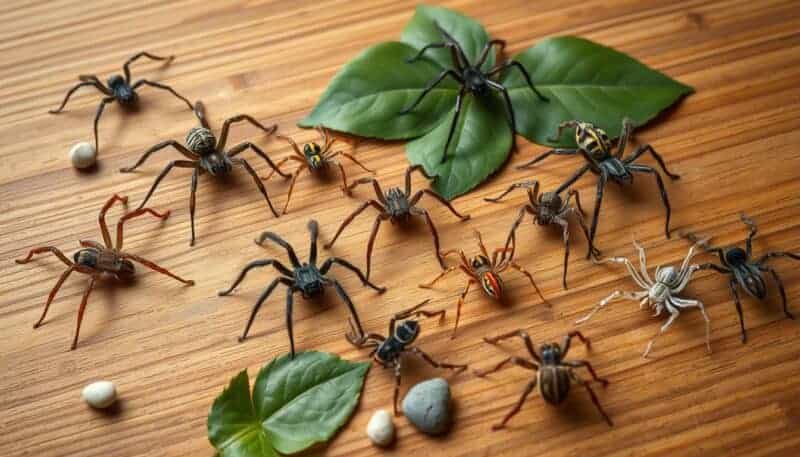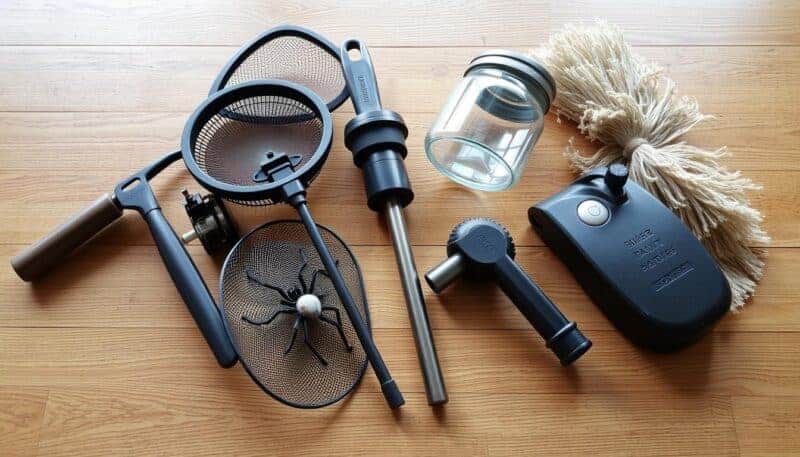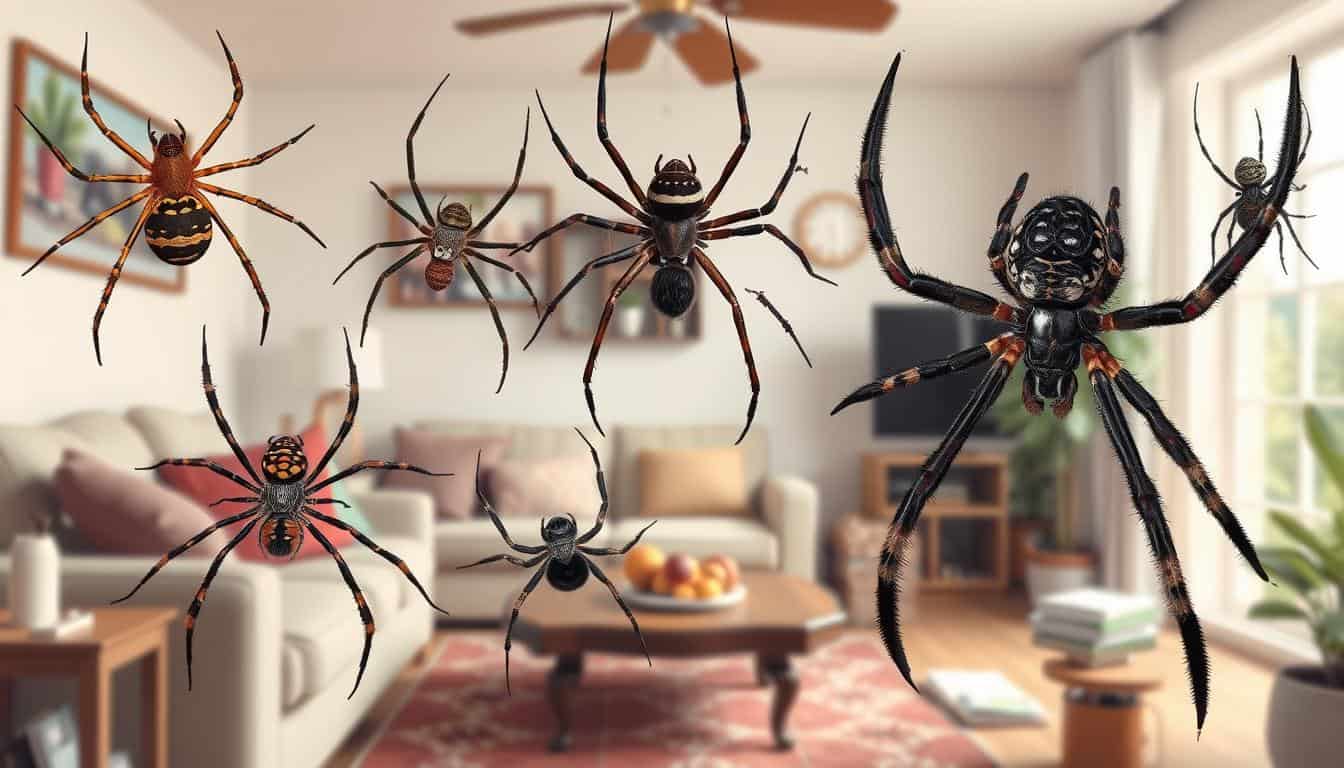Introduction
Did you know there are over 45,000 spider species worldwide? Hundreds live in American homes. This guide will assist you to recognize and understand common indoor spiders. We’ll look at their benefits, behaviors, and how to live with them.
Indoor spiders, like cobwebs and cellar spiders, are important for your home’s balance. Learning about their traits and habits can make you appreciate them more. They play a key role in our natural world.
- Understanding Common Household Spiders and Their Role
- Most Common Indoor Spiders in American Homes
- Identifying Different Spider Species by Appearance
- Spider Behavior and Daily Patterns
- Preferred Spider Habitats Within Your Home
- Distinguishing Harmless vs. Dangerous Species
- Natural Prevention Methods for Indoor Spiders
- Safe Spider Removal Techniques
- Creating a Spider-Resistant Environment
- When to Seek Professional Pest Control
- FAQ:
- What is the most common indoor spider?
- Is it OK to have a spider in your room?
- What is the most aggressive house spider?
- What does it mean when you have spiders in your house?
- Should I sleep in my bed if I found a spider?
- Are spiders scared of humans?
- What is the friendliest spider to own?
- What do house spiders hate the most?
- Will a spider bite me in my sleep?
- Will a spider crawl in my ear?
Understanding Common Household Spiders and Their Role
Spiders might make us feel uneasy, but they are crucial for our homes. They help control pests and keep our indoor environment balanced. Common household spiders are key to our homes’ health.
Benefits of Spiders in Your Home
Having spiders in your home is not a bad thing. They eat many insects, like flies and mosquitoes. This helps keep your home pest-free and healthier.
Natural Pest Control Functions
Spiders are great hunters. They use their webs to catch and eat many insects. This stops pests from being a problem or a health risk.
Spider Ecosystem Balance
Spiders do more than just control pests. They help keep the ecosystem in your home balanced. By eating insects, they prevent any one species from taking over. This makes your home a diverse and thriving place.
“Spiders are often misunderstood, but they play a vital role in maintaining the balance of nature, even within our homes.”
Most Common Indoor Spiders in American Homes
If you’ve seen spiders in your home, you’re not alone. Indoor spiders, or house spiders, are common in many American homes. They come in different shapes, sizes, and colors. Knowing the most common types can help you identify them and address any concerns.
The Cellar Spider, also called the Daddy Longlegs, is very common. They have long, thin legs and live in damp, dark places like basements and closets. The House Spider is also common. It has a round, brown body and messy webs.
The Grass Spider often lives in corners or under furniture. They are gray or brown and have funnel-shaped webs. The Jumping Spider is known for its large eyes and ability to jump.
| Spider Species | Characteristics | Common Locations |
|---|---|---|
| Cellar Spider (Daddy Longlegs) | Lanky, long legs | Basements, closets, crawl spaces |
| House Spider | Round, brown body | Corners, under furniture |
| Grass Spider | Gray or brown, funnel-shaped web | Corners, under furniture |
| Jumping Spider | Large eyes, leaping ability | Variety of indoor locations |
Knowing about these common indoor spider species helps you understand your home’s eight-legged residents. You can then decide how to live with them or manage their presence.
Identifying Different Spider Species by Appearance
Learning to identify spiders can make them more interesting. By looking at their visual traits, you can spot different species in your home. Details like web patterns, body shapes, and colors are key to identifying spiders.
Web Patterns and Structure Types
Spiders are known for their web-building skills. The patterns and structures of their webs can help identify them. For example, orb-weaver spiders make spiral webs, while funnel-web spiders create tunnel-like webs.
Body Shapes and Colorations
Spiders come in all shapes and colors. Some, like the black house spider, are sleek. Others, like the Phidippus audax (bold jumping spider), have bright colors and patterns. Looking closely at a spider’s body can tell you its species.
Size Variations Among Species
Spider size is also important for identification. Some spiders, like the common house spider, are small. Others, like the giant house spider, are quite large. Knowing the typical sizes of different species helps in identifying them.
| Spider Species | Web Pattern | Body Shape | Size Range |
|---|---|---|---|
| Orb-weaver Spider | Spiral-shaped web | Round, bulbous abdomen | 0.5 to 1.5 inches |
| Funnel-web Spider | Tunnel-like web | Elongated, cylindrical body | 1 to 2 inches |
| Black House Spider | Irregular, messy web | Streamlined, smooth appearance | 0.25 to 0.5 inches |
| Phidippus audax (Bold Jumping Spider) | No web (hunts by jumping) | Compact, stocky build with vibrant colors | 0.5 to 0.75 inches |
| Giant House Spider | Irregular, non-geometric web | Large, hairy body | 1 to 3 inches |
By observing web patterns, body shapes, colors, and sizes, you can improve your spider identification skills. This knowledge will not only satisfy your curiosity but also help you understand the diverse spider populations in your home.
Spider Behavior and Daily Patterns
Exploring the world of common household spiders reveals their fascinating behavior and daily routines. These arachnids have unique behaviors that help them survive indoors.
Spiders are skilled hunters, using their webs to catch prey. The orb-weaver spider’s webs are intricate, while crab spiders ambush their prey. Their hunting methods show their intelligence and adaptability.
Spiders also have interesting mating and reproduction habits. The jumping spider performs elaborate courtship dances. The black house spider guards its egg sacs fiercely. These behaviors highlight the delicate balance in their lives.
Spiders interact with their environment in fascinating ways. They detect vibrations and changes in air. They prefer dark, secluded spots. By watching their daily activities, we learn more about their behavior and habitats.
“Spiders are the most misunderstood creatures on the planet. They’re not out to get you; they’re just trying to live their lives.” – Entomologist, Dr. Jessica Ware
As you learn more about indoor spiders, you’ll be amazed by their survival strategies. These animals have adapted well to living with humans.
Preferred Spider Habitats Within Your Home
Learning where indoor spiders hide can help you manage them better. Whether it’s common house spiders or others, knowing their favorite spots is crucial. This knowledge helps you keep them under control.
Common Indoor Nesting Areas
Spiders like quiet, hidden spots to spin webs and raise young. They often nest in:
- Behind furniture, appliances, and shelving units
- Inside closets, attics, and basements
- Around windows, door frames, and other entry points
- In garages, sheds, and other semi-enclosed structures
Environmental Conditions They Prefer
Spiders love warm, humid places with lots of food and water. They prefer areas with:
- Moderate to high humidity levels
- Minimal air circulation and plenty of hiding spots
- Abundant insect populations for them to prey upon
Seasonal Location Changes
Spiders’ locations change with the seasons. Some move deeper into homes for warmth in cold months. Others become more active in search of mates and food.
Knowing where spider habitats are in your home helps you manage them. This way, you can keep your living space comfortable and spider-free.
Distinguishing Harmless vs. Dangerous Species
It’s important to know the difference between harmless and dangerous indoor spiders. Knowing how to identify spiders helps you understand the risks. This way, you can take the right steps for spider control. Let’s look at the main differences between common household spiders and the ones that are more dangerous.
Identifying Venomous Spiders
The black widow and brown recluse are the most dangerous spiders in American homes. The venom of these animals can be deadly to humans, however bites are very rare.
- Black widows have shiny, black bodies and a red hourglass shape on their belly.
- Brown recluses have a violin-shaped mark and are light to medium brown.
Assessing the Risks
While venomous spider bites can be serious, they rarely cause major harm or death. Most common household spiders are harmless and don’t pose a risk to humans.
| Spider Species | Venom Potency | Bite Severity |
|---|---|---|
| Black Widow | Highly Potent | Can Cause Severe Symptoms |
| Brown Recluse | Moderately Potent | Can Cause Tissue Damage |
| House Spider | Minimal Potency | Typically Harmless |
| Cellar Spider | Minimal Potency | Typically Harmless |
Most common household spiders are not dangerous. They can be safely removed or left alone. By knowing the differences, you can identify spiders and handle them properly.

Natural Prevention Methods for Indoor Spiders
Dealing with unwanted spiders in your home doesn’t have to mean harsh chemicals. You can use natural and eco-friendly ways to keep them away. From home maintenance to natural deterrents, there are many spider prevention strategies.
Home Maintenance Tips
Keeping your home in good shape helps with spider management. Check and seal any cracks or openings. This stops spiders from getting in. Also, make sure your home is well-ventilated and not too damp, as spiders like moisture.
Decluttering and reducing hiding spots makes your home less appealing to spiders. This can help keep them away.
Natural Deterrents
- Essential oils like peppermint, citronella, and tea tree oil can act as natural spider control agents when applied around entry points and potential nesting areas.
- Vinegar, diatomaceous earth, and chalk are also effective in deterring spiders from entering your home.
- Planting herbs like lavender, basil, and marigolds around your home’s perimeter can help repel spiders naturally.
Sealing Entry Points
It’s important to find and seal entry points for spider prevention. Use caulk, weatherstripping, or other sealants to close gaps. Focus on areas like windows, doors, and pipes, as spiders often enter here.
| Natural Spider Prevention Method | Benefits |
|---|---|
| Essential Oils | Repel spiders with their strong scents |
| Vinegar | Disrupts spider pheromones and deters them |
| Diatomaceous Earth | Damages spider exoskeletons, causing dehydration |
Using these natural spider prevention methods helps keep your home spider-free. They are safe and eco-friendly. Regular home maintenance and vigilance also help control indoor spider populations.
Safe Spider Removal Techniques
Managing indoor spiders safely is key. There are many ways to control spider populations in your home without harm. Let’s look at some top methods for spider control and management.
Catch-and-Release Method
The catch-and-release method is very humane. It involves catching the spider gently and then releasing it outside. This keeps it away from your home.
- Approach the spider calmly and slowly.
- Gently place a cup or jar over the spider, trapping it inside.
- Slide a piece of paper or cardboard under the container to seal it.
- Carry the spider outside and release it in a safe, natural area away from your home.
Use Appropriate Tools
Having the right tools is crucial for removing indoor spiders. You might need a broom, vacuum, or a spider-catching tool. Avoid harsh chemicals or insecticides, as they can harm both the spider and your family.

“The best way to handle spiders is to treat them with respect and remove them safely, rather than trying to kill them.”
By using these safe and humane methods, you can manage indoor spider populations well. This way, you protect your family and the environment.
Creating a Spider-Resistant Environment
To keep your home spider-free, you need a few key steps. Understanding what draws spiders and using the right strategies can help. Let’s look at how to make your home less welcoming to spiders.
Humidity Control Methods
Spiders love damp, humid places for their webs and food. To keep them away, control your home’s humidity. Use dehumidifiers, ensure good air flow, and fix any moisture issues. A dry, well-ventilated home is less appealing to spiders.
Lighting Adjustments
Lighting affects spider prevention too. Spiders are drawn to bright, warm lights that attract insects. Switch to LED bulbs that are cooler and less attractive to spiders. Place these lights away from where spiders might enter.
Cleaning Practices
Keeping your home clean is vital for spider prevention. Vacuum, sweep, and wipe down surfaces to remove webs and eggs. Focus on corners and crevices where spiders hide. This makes your home less welcoming to them.
Combining humidity control, smart lighting, and cleaning can make your home spider-resistant. These steps not only keep spiders away but also make your home healthier and more comfortable.
When to Seek Professional Pest Control
Managing spider infestations at home can be tough. Sometimes, you need to call in the experts. If you’ve tried everything at home and still have a problem, it’s time to get help.
Spider control experts have the skills and tools to solve your problem. They know how to get rid of spiders for good. They can find out what kind of spiders you have and make a plan to get rid of them.
If you see more spiders, find nests, or get bitten, get help fast. Pest control pros can keep your family safe. They’ll make sure your home is spider-free again.
FAQ:
What is the most common indoor spider?
Among indoor spiders, the common house spider is the most frequently encountered. These small, unassuming arachnids weave tangled webs in corners and quiet spaces. Adapted to human dwellings, indoor spiders like these thrive in basements, attics, and garages, playing a vital role in controlling pests while remaining largely unnoticed.
Is it OK to have a spider in your room?
Having indoor spiders in your room is generally harmless and can even be beneficial. These quiet inhabitants help manage pests like flies and mosquitoes. Most indoor spiders are non-aggressive and prefer avoiding humans. With their minimal presence, they contribute to a natural balance without posing a threat to your living space.
What is the most aggressive house spider?
Among indoor spiders, the hobo spider is often regarded as one of the more aggressive. Known for its defensive nature, it may bite if threatened or cornered. Despite its reputation, bites from hobo spiders are rare and usually non-lethal. Like most indoor spiders, it primarily focuses on capturing insects.
What does it mean when you have spiders in your house?
Having indoor spiders in your house often signifies a healthy ecosystem. These arachnids are attracted by abundant prey, such as insects, which thrive in cluttered or undisturbed areas. While their presence might seem unsettling, indoor spiders act as natural pest controllers, maintaining balance and reducing the need for chemical interventions.
Should I sleep in my bed if I found a spider?
Finding indoor spiders in your bed is usually harmless, as they tend to avoid human interaction. Most indoor spiders pose no threat and will likely relocate on their own. If concerned, gently remove the spider using a cup and paper before sleeping, ensuring both your comfort and the spider’s safety.
Are spiders scared of humans?
Most indoor spiders are indeed scared of humans. Their natural instinct is to avoid large predators, including us. These timid creatures prefer secluded corners and rarely venture out unless disturbed. While their movements might seem bold, indoor spiders are more interested in escaping potential threats than engaging with humans.
What is the friendliest spider to own?
Among indoor spiders, the bold jumping spider is often considered the friendliest to own. Known for its curious and interactive nature, it readily observes and even recognizes its keeper. Unlike many other indoor spiders, this species displays minimal aggression, making it a delightful and engaging pet for arachnid enthusiasts.
What do house spiders hate the most?
Indoor spiders detest strong scents like peppermint, citrus, and vinegar, which overwhelm their sensory systems. They also dislike frequent disturbances, bright lights, and dry environments. Keeping areas clean and clutter-free reduces hiding spots, creating inhospitable conditions for indoor spiders and encouraging them to seek refuge elsewhere, away from human spaces.
Will a spider bite me in my sleep?
It’s highly unlikely that indoor spiders will bite you in your sleep. These creatures are non-aggressive and prefer to avoid humans. Most indoor spiders only bite defensively when provoked, which is rare in a resting scenario. Their primary focus is on capturing insects, not interacting with people during the night.
Will a spider crawl in my ear?
It is highly unlikely for indoor spiders to crawl into your ear. These creatures prefer dark, undisturbed corners rather than venturing into human ears. While the idea can be unsettling, most indoor spiders are harmless and avoid contact with humans unless disturbed, making such incidents extremely rare and improbable.
Share your thoughts in the comments below! If you enjoyed this post, consider subscribing to our newsletter for more pet tips, stories and blogs!

